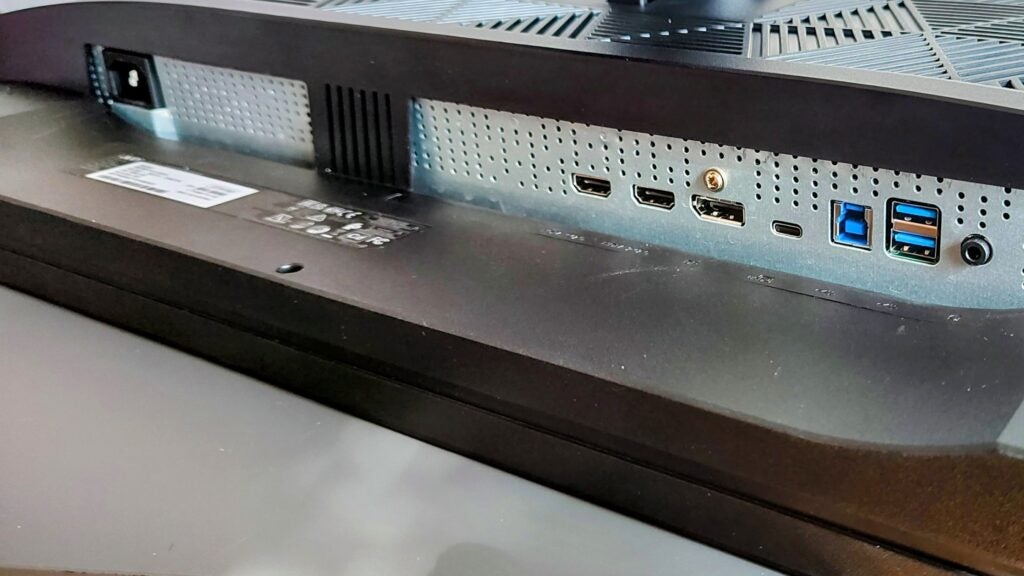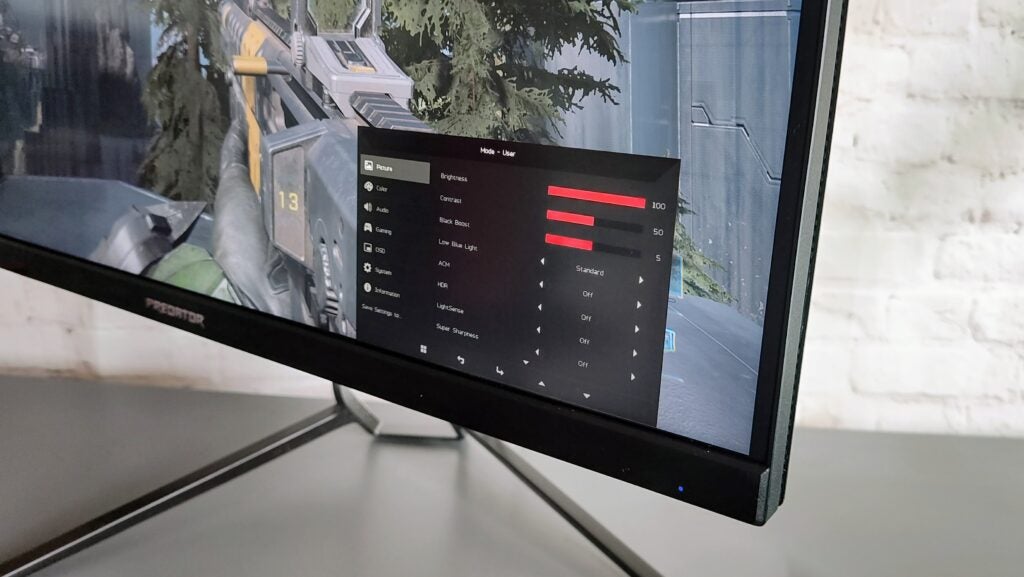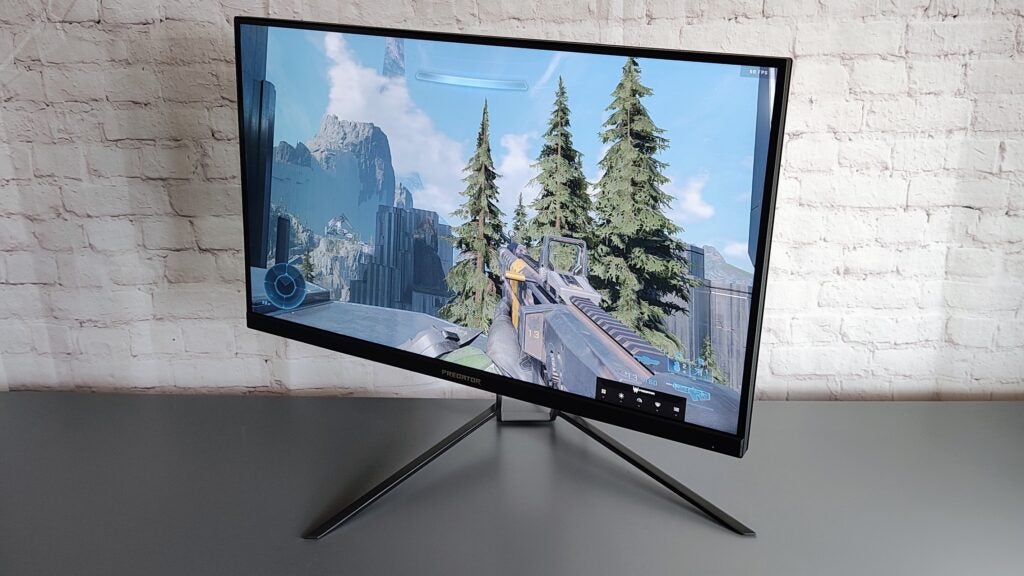Verdict
The Acer Predator XB323QK is a fast and feature-laden 31.5-inch 4K gaming monitor that’s accurate enough for creative use and comes with a 5-port USB hub. Only the rudimentary HDR performance lets it down
Pros
- Colourful, bright and colour-accurate
- Sharp and bright 4K panel
- Good refresh rate and response times
- USB hub for work, RGB backlight for play
Cons
- Minimal HDR capability
- OSD navigation is rather frustrating
- Loud but raucous speakers
- Clunky KVM implementation
-
A 4K UHD panel with a 144Hz refresh rateThe 3840 x 2160 140-nit resolution guarantees a super-crisp viewing experience while 144Hz is fast enough for most gamers.
-
5-port USB HubPacks four USB-A 3.1 Gen 1 ports for your connectivity needs and a 65W PD Type-C port to keep your laptop charged. -
RGB backlight barIt may just be eye candy but who doesn’t like a pulsating glow that works in sync with your games, videos and music?
Introduction
The Acer Predator XB323QK monitor aspires to be all things to all people. Well, most people.
PC gamers will be lured by the great response times, console fans by the brace of HDMI 2.1 ports with support for VRR while the rest of humanity will be impressed by the bright, colourful and crisp 4K display and abundant connectivity. Only aficionados of HDR are left outside the tent peering in.
You get all that for a decent price too. Right now Acer is offering the Predator XB323 for £799 thanks to a £200 discount off the suggested RRP of £1000, which makes it much the same price as the similarly-specified Aorus FI32U and cheaper than the again similar ROG Swift PG32UQ.
Design and Features
- A great-looking monitor for gaming, entertainment and work
- Useful 4-port USB hub with Type-C PD charging
- Funky RGB light show for party time
There’s no doubt that the Acer Predator XB323QK looks and feels like a premium product. The top and side bezels are a slender 8mm, while the chin at the bottom is hardly a Desperate Dan affair at 25mm. It’s a reasonably grown-up design – in fact, the only giveaway that it’s primarily a gaming accessory is the restrained Predator logo at the bottom.
Setting up requires some care, because at 12kg (including the substantial metal stand) it’s not that light. There’s a wide 58cm gap between the ends of the stand forks making it only 13cm narrower than the monitor itself but the forks are quite slender so they don’t rob too much desk space. The stand attaches to the monitor body with a quick-release clip, but there is a 100mm VESA mount hidden beneath that.

I’d rate adjustability as good rather than great. The 130mm of height adjustment is rather more generous than some as is the 30° swivel to both left and right. The -5° to +25° tilt is par for the course, but there’s no rotation on offer, let alone through 90° into portrait mode so there’ll be no spinning it around to better play vertical scrolling shooters.
Upend the Acer Predator XB323QK and you’ll discover two HDMI 2.1 (good for 4K 120Hz VRR gaming with the latest consoles) and one DisplayPort 1.4 video input, one USB-C port that supports 65W PD charging and DP-Alt Mode, one USB-B upstream and two USB-A 3.1 Gen 1 downstream data ports and a 3.5mm audio output. The Type-C port can be set to charge even when the monitor is off, which is a useful feature. Two more USB-A ports reside on the left-hand side for more easy access.

In the absence of a dedicated KVM switch, swapping between two input sources and using the same peripherals with both involves switching both the video input feed and the USB feed in the OSD which is a bit of palaver.
The back of the XB323 is home to a very bright RGB light strip that runs along the top and sides of the rear housing. This can be set to pulse, throb, strobe or just glow in any one of a number of colours via the OSD, or you can install the Acer Light Sense app which lets you sync the light show with what the screen is displaying or in time to your music.

One thing physically lacking from the XB323 is cable anchors or grips to prevent drag on your mouse cable. I like to see these fitted to cheap gaming monitors so I really, really, expect to find them on monitors costing as much as the XB323.
The OSD is navigated via a row of five buttons below the right edge of the panel. As OSDs go, the Acer menu structure is reasonably easy to move around, helped by a continuous on-screen indicator telling you what each button does in any given circumstance. The problem is the power button which is the fifth in the row, a position that meant I often put the screen into standby when what I wanted to do was to move down a menu list. Downloading Acer’s Display Widget app gives you much of the core OSD functionality – and some extra features like various screen modes – with a lot less agro.

Buried inside the XB323 are a brace of 4W speakers, and while they are certainly loud they are also rather raucous and lacking in bass. At maximum volume, the soundscape is not what I would describe as easy on the ear, so while they are okay for gaming they can’t be recommended for listening to music or movie soundtracks.
The eagle-eyed among you will have noticed the small gloss rectangle below the display. That houses the light sensors that can be used to adjust the panel brightness in accordance with the ambient surroundings or turn the panel off when it notices that you are no longer sitting in front of it.
Image Quality
- Supremely crisp and colourful
- Great motion handling
- HDR performance is basic
The IPS panel on the Acer Predator XB323QK is an absolute cracker and may be one of the most versatile screens I’ve ever come across. Just so long as you don’t want anything too much in the way of HDR performance.
Let me address that elephant in the room first: with only an entry-level DisplayHDR 400 certification and no sort of local area dimming, the XB323’s HDR performance is perfunctory at best.
Running the likes of Halo Infinite and Cyberpunk 2077 in HDR, it’s obvious that Acer has put more thought than some OEMs into balancing the HDR colour palette so everything looks more saturated and vivid, especially when hooked up to a PS5. But that’s about as far as it goes. The extended contrast ratio necessary for good Windows HDR just isn’t there.

With the bad news out of the way let’s turn to the good. The combination of what Acer calls an Agile Splendor (key points are fast response times and wide DCI-P3 gamut coverage) IPS panel with a 3840 x 2160 31.5-inch format makes for a supremely crisp (140dpi) display with very robust viewing angles and plenty of speed. Maximum refresh rate is pegged at 144Hz, while the quoted response rates are indeed quite splendid at 1ms GtG and 0.5ms MPRT.
The way the Acer Predator XB323QK handles motion is very impressive, with very little ghosting visible even with the overdrive turned off. Switching the overdrive up to Normal makes a small improvement while turning it to Extreme delivers a whole heap of overshoot so my advice is to leave it on Normal.
The XB323 is certified G-Sync Compatible which means it supports Adaptive Sync, but doesn’t have a G-Sync module for the full proprietary Nvidia experience. I didn’t experience any vertical or horizontal screen tearing while playing Forza Horizon 5 or running the Nvidia pendulum test, which is always a good sign that your display and GPU are reading from the same hymn sheet.

Point a colourimeter at the XB323 and you won’t be disappointed by the results. Maximum brightness was recorded at a pretty solid 384 nits, while the contrast ratio of 910:1 was perfectly acceptable even if the black luminescence of 0.41 nits was a little on the high side.
There was plenty of colour in evidence thanks to 99.2% coverage of the sRGB gamut from a volume of 120.1%. The DCI-P3 and Adobe RGB gamuts came in at 87.5% and 77.9% respectively which is solid, even if the former is a little lower than Acer’s claimed 90%.
The Acer Predator XB323QK comes preloaded with five colour profiles; Rec. 709, sRGB, DCI-P3, EBU and SMPTE-C along with General and HDR settings. With the sRGB clamp engaged the Delta E colour accuracy was very impressive with a result of 0.94. The panel also carries a TÜV Rheinland certification for low blue light emission which is handy if you plan on spending long work days in front of it.
Measuring panel uniformity didn’t show any significant issues with backlight bleeding or clouding. There are some small variances in the ISO 14681 test towards the right edge of the screen, but all 25 swatches fell within the recommended or nominal category when it came to average luminance.
Latest deals
Should you buy it?
You want an all-round 4K gaming monitor:
The Acer Predator XB323QK is colourful, colour-accurate, bright, fast and pin-sharp. That’s all I want from a gaming monitor and the Acer delivers it in spades.
You want a good HDR performance:
At the risk of stating the obvious, if you want good HDR performance on a gaming display don’t go down the IPS route. You really need to be looking at an OLED monitor.
Final Thoughts
For £800 the Acer Predator XB323QK is one of the best all-around monitors on the market if you take HDR performance out of the equation. The large, tack-sharp 4K display, wide and accurate colour coverage, speedy response and refresh times and handy USB hub make it a jack of all trades and a master of most of them. Highly recommended if you need one monitor to do everything and to a high standard.
How we test
We use every monitor we test for at least a week. During that time, we’ll check it for ease of use and put it through its paces by using it for both everyday tasks and more specialist, colour-sensitive work.
We also check its colours and image quality with a colorimeter to test its coverage and the display’s quality.
We used it as our main monitor for at least a week.
We used a colorimeter to get benchmark results.
We used our own expert judgement for image quality.
FAQs
Indeed it is. It has the speed and capability to excel at gaming while at the same time having the basic technical quality and features to serve as a very good tool for creative work or general productivity.
Any 32in monitor will take up a fair amount of space and the stand that comes with the Predator is very wide but it will still sit on a standard 60 x 100cm Ikea desk with enough free space for your peripherals, including a printer, and other gubbins.
Trusted Reviews test data
Jargon buster
Refresh Rate
The number of times the screen refreshes itself per second.
Variable Refresh Rates
Variable Refresh Rate enable a game console/PC to send video frames as quick as possible to a display, with the screen adapting its own refresh rate in real-time to match the source, reducing visual artefacts and offering a more responsive performance

























